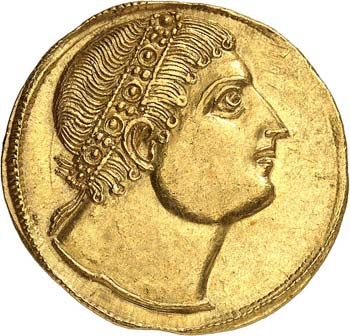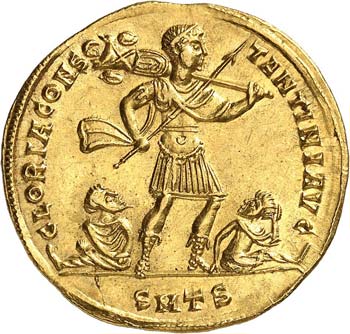- Home
- Numismatic Auction 17
- 111 Constantin Ier le Grand (310-337) Médaillon d’un solidus ...
Лот 111 - Numismatic Auction 17
Оферты
Описание
Médaillon d’un solidus et demi - Thessalonique (327)
D’une insigne rareté et d’une qualité remarquable.
Exemplaire de la collection « de Guermantes » vente Leu 86 du 5 mai 2003, N°985 et de la vente NAC 52 du 7 octobre 2009, N°608
6.71g - Gnecchi p. 17, 23 et pl. 7, 5 Bastien, Donativa, cf. p. 80, note 2.
Pratiquement FDC - CHOICE AU *
Rather than the laurel wreath that identified emperors as commanders-in-chief, this remarkable anepigraphic portrait shows Constantine wearing a diadem – an innovation dating back to AD 324 which recalls royal Hellenistic portraits, looking upward in an attitude of prayer (his eyes turned up to the heavens) which was well noticed by Christians, as testified by Bishop Eusebius of Caesarea in his Vita Constantini (IV.15): “The great strength of the divinely inspired faith fixed in his soul might be deduced by considering also the fact that he had his own portrait so depicted on the gold coinage that he appeared to look upwards in the manner of one reaching out to God in prayer. Impressions of this type were circulated throughout the entire Roman world”. After forty years of internal wars, Constantine’s defeat of Licinius I at Chrysopolis in AD 324 had reunified the empire under a single emperor. In November that year he drew the plans of a new much-enlarged city of Constantinople (former Byzantius, and future Istanbul), which would then be inaugurated as the new capital city in May AD 330, and in AD 325 he convened at Nicaea and personally oversaw an ecumenical council of Christian bishops. These, and numerous administrative reforms, gave him much to celebrate, and this medallion belongs to the monuments that mark his successes. Its reverse depicts the Emperor standing be- tween two bound captives, and it was struck at the time of his vicennalia (he was to become the longest reigning Roman emperor since Augustus), which was also the decennalia of his son Constantine II Caesar (it was customary for emperors to celebrate their accession to the throne every five years, with festivities and donatives). This medallion was struck in Thessaloniki, which was a step of the emperor’s vicennial journey. Indeed, Constantine had left Nicomedia (Isnik in Turkey) in early AD 326 and arrived in Rome (the ‘old capital’) in July, and then left Rome in September to arrive back in Nicomedia in July AD 327, having visited Thessalonica, Sirmium and Ticinum on the way: “A stop in Thessalonika [in late February 327] is recorded in Codex Theodosianus for the return journey, and […] one might postulate that Constantine travelled the same route via Thessalonika also on the outward vicennial journey [in April 326]” (L. Ramskold, “Constantine’s Vicennalia and the Death of Crispus”, Niš & Byzantium conference XI (2012), pp. 409-456).
Используйте форму для регистрации или введите логин в правой части формы.
За дополнительной информацией обращайтесь palombo.geneve@gmail.com
Категории
Аукцион: Numismatic Auction 17
- Greek Coins
- Roman Coins
- French West Africa
- South Africa
- Albania
- Germany
- Great Britain
- Annam
- Saudi Arabia
- Australia
- Austria
- Belgium
- Brasil
- Cambodia
- Chile
- China
- Cochincina
- Colombia
- Croatia
- Cuba
- Egypt
- Ecuador
- Eritrea
- Spain
- Ethiopia
- France
- Greece
- Guadeloupe
- Guatemala
- Hungary
- Dutch East Indies
- Portuguese India
- French Indochina
- Iraq
- Ireland
- Italy
- Japan
- Liechtenstein
- Lithuania
- Luxembourg
- Madagascar
- Marocco
- Martinica
- Mauritius
- Mexico
- Monaco
- Palestine
- Netherlands
- Peru
- Portugal
- Qatar and Dubaï
- Réunion and Mauritius
- Romania
- Russia
- Salvador
- Serbia
- Switzerland
- Tonkin
- Transylvania
- Tunisia
- Turkey
- Usa
- Vatican
- Venezuela
- Yugoslavia
Расписание
Предаукционный - Окончание
20 10 2018 07:00 CEST
Аукцион в зале - Начало
20 10 2018 10:30 CEST
контакты
Rue de la cité, 27, Genève, 1204, Switzerland
Cabinet Numismatique - Maison Palombo S.A. /// Rue de la cité, 27 - 1204 Genève - Suisse
tel : 0041-(0)22-310-91-97 /// fax : 0041-(0)22-310-30-74 /// Email : palombo.geneve@gmail.com /// www.maison-palombo-geneve.com
Powered by bid-KIT®
 Политика использования файлов cookie
Политика использования файлов cookie
Этот сайт использует файлы cookie для улучшения взаимодействия с пользователем и сбора информации об использовании сайта. Вы можете ознакомиться с нашей политикой использования файлов cookie, принять все файлы cookie и продолжить просмотра, нажав "Принять" или измените свой выбор, нажав "Настроить".
Политика использования файлов cookie
Файлы cookie
Чтобы этот сайт работал должным образом, мы иногда устанавливаем на ваше устройство небольшие файлы данных, называемые " cookie ". Большинство крупных сайтов делают то же самое.
Что такое файлы cookie?
Файл cookie - это небольшой текстовый файл, который веб-сайты сохраняют на вашем компьютере или мобильном устройстве во время их посещения. Благодаря файлам cookie сайт запоминает ваши действия и предпочтения (например, логин, язык, размер шрифта и другие параметры отображения), чтобы вам не приходилось повторно вводить их, когда вы возвращаетесь на сайт или переходите с одной страницы на другую.
Как мы используем файлы cookie?
Сторонние файлы cookie
Google Analytics
Этот сайт использует Google Analytics для сбора информации об использовании пользователями его веб-сайта. Google Analytics генерирует статистическую и другую информацию с помощью файлов cookie, хранящихся на компьютерах пользователей. Информация, полученная в отношении нашего веб-сайта, используется для составления отчетов об использовании веб-сайтов. Google будет хранить и использовать эту информацию. Политика конфиденциальности Google доступна по следующему адресу: https://policies.google.com/privacy .
Для работы сайта не обязательно включать файлы cookie, но это улучшает навигацию. Можно удалить или заблокировать файлы cookie, но в этом случае некоторые функции сайта могут работать некорректно.Информация о файлах cookie не используется для идентификации пользователей, и данные навигации всегда находятся под нашим контролем. Эти файлы cookie используются исключительно для целей, описанных здесь.
Как контролировать и изменять файлы cookie?
Вы можете изменить или отозвать свое согласие в любое время в декларации файлов cookie на наш сайт.
Политика конфиденциальности
Узнайте больше о том, кто мы такие, как вы можете связаться с нами и как мы обрабатываем личные данные, в нашем политика конфиденциальности .
Необходимые файлы cookie помогают сделать веб-сайт пригодным для использования за счет включения основных функций, таких как навигация по страницам и доступ к защищенным областям сайта. Веб-сайт не может нормально функционировать без этих файлов cookie.
| Имя | Поставщик | Цель | Срок действия |
|---|---|---|---|
| cookieConsent | Bid Inside | Сохраняет статус согласия пользователя на cookie для текущего домена | 6 месяцев |
| PHPSESSID | Bid Inside | Сохранять статус пользователя на разных страницах сайта. | Когда сеанс просмотра заканчивается |
| f_display | Bid Inside | Файлы cookie f_display запоминают режим отображения, выбранный пользователем на страницах, где есть списки. | Когда сеанс просмотра заканчивается |
| f_page | Bid Inside | Файлы cookie f_page хранят страницу, просмотренную пользователем, на страницах, где есть списки. | Когда сеанс просмотра заканчивается |
| f_rec_page | Bid Inside | Файлы cookie f_rec_page хранят количество элементов, которые должны отображаться на странице, выбранной пользователем на страницах, на которых есть списки. | Когда сеанс просмотра заканчивается |
| f_order_by | Bid Inside | Файлы cookie f_order_by хранят выбранный пользователем параметр сортировки на страницах, где есть списки. | Когда сеанс просмотра заканчивается |
| f_order_dir | Bid Inside | Файлы cookie f_order_dir хранят направление упорядочивания, выбранное пользователем на страницах, где есть списки. | Когда сеанс просмотра заканчивается |
| watch_list_show_imgs | Bid Inside | Файл cookie watch_list_show_imgs хранит выбор пользователя, отображать или скрывать изображения лотов на странице списка наблюдения | Когда сеанс просмотра заканчивается |
| selected_voice | Bid Inside | В файле cookie selected_voice хранится голос, выбранный пользователем для синтеза речи, присутствующий на живом аукционе | 1 Месяц |
| include_autobids | Bid Inside | Файл cookie include_autobids сохраняет выбор пользователя — показывать или скрывать свои auto-bid на странице «Ваши ставки». | 6 месяцев |
Аналитические файлы cookie помогают понять, как посетители взаимодействуют с веб-сайтом, собирая и передавая статистическую информацию контроллеру данных.
| Имя | Поставщик | Цель | Срок действия |
|---|---|---|---|
| _ga | Зарегистрируйте уникальный идентификатор, используемый для генерации статистических данных о том, как посетитель использует веб-сайт. | 2 года | |
| _gat_gtag | Используется Google Analytics для ограничения частоты запросов | 1 день | |
| _gat | Используется Google Analytics для ограничения частоты запросов | 1 день | |
| _gid | Зарегистрируйте уникальный идентификатор, используемый для генерации статистических данных о том, как посетитель использует веб-сайт. | 1 день | |
| __utma | Bid Inside | Используется для различения пользователей и сеансов. Файл cookie создается, когда библиотека javascript выполняется, а существующие файлы cookie __utma не существуют. Файл cookie обновляется каждый раз, когда данные отправляются в Google Analytics. | 2 годы |
| __utmt | Bid Inside | Используется для ограничения скорости запросов. | 10 минут |
| __utmb | Bid Inside | Используется для определения новых сеансов / посещений. Файл cookie создается, когда библиотека javascript выполняется, а существующие файлы cookie __utmb не существуют. Файл cookie обновляется каждый раз, когда данные отправляются в Google Analytics. | 30 минут |
| __utmc | Bid Inside | Не используется в ga.js. Набор для взаимодействия с urchin.js. Исторически этот файл cookie работал вместе с файлом cookie __utmb, чтобы определить, был ли пользователь в новом сеансе / посещении. | Когда сеанс просмотра заканчивается |
| __utmz | Bid Inside | Сохраняет источник трафика или кампанию, объясняющую, как пользователь попал на ваш сайт. Файл cookie создается при запуске библиотеки javascript и обновляется каждый раз, когда данные отправляются в Google Analytics. | 6 месяцы |
| __utmv | Bid Inside | Используется для хранения данных пользовательских переменных на уровне посетителя. Этот файл cookie создается, когда разработчик использует метод _setCustomVar с настраиваемой переменной уровня посетителя. Этот файл cookie также использовался для устаревшего метода _setVar. Файл cookie обновляется каждый раз, когда данные отправляются в Google Analytics. | 2 годы |
Предпочтительные / технические файлы cookie позволяют веб-сайту запоминать информацию, которая влияет на то, как сайт ведет себя или представляет себя, например, ваш предпочтительный язык или регион, в котором вы находитесь.
Мы не используем файлы cookie этого типа.Профилирующие файлы cookie используются в маркетинговых целях для отслеживания посетителей веб-сайта. Их цель - отображать релевантную и привлекательную рекламу для отдельного пользователя.
Мы не используем файлы cookie этого типа.Неклассифицированные файлы cookie - это файлы cookie, которые классифицируются вместе с отдельными поставщиками файлов cookie.
Мы не используем файлы cookie этого типа.





 112
112